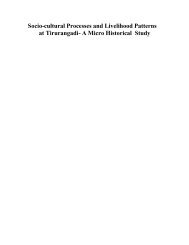Psycho-social problems of women who had undergone hysterectomy
Psycho-social problems of women who had undergone hysterectomy
Psycho-social problems of women who had undergone hysterectomy
You also want an ePaper? Increase the reach of your titles
YUMPU automatically turns print PDFs into web optimized ePapers that Google loves.
Session II: Guide to controlling one’s own recovery: emphasis that each woman isan individual and will have a unique recovery. Avoidance <strong>of</strong> adverse comparisonswith other <strong>women</strong> advised. Tiredness or what one feels like doing are guides forresuming activities. When one feels ready to try a new activity, do so gently atfirst. If all goes well, carry on and increase this activity. If, however, it seems toomuch and one feels over-tired, this is a sign that one needs to wait a little longerbefore trying again. In this way, activities will be gradually increased until theyreach normal levels again.Session III: Ventilation <strong>of</strong> patient’s feelings about having a <strong>hysterectomy</strong>: all<strong>women</strong> were asked, “ How do you feel in yourself about having <strong>had</strong> a<strong>hysterectomy</strong>?”Session IV: Effects <strong>of</strong> <strong>hysterectomy</strong>ROLE OF OVARY AFTER HYSTERECTOMY:Ovaries preserved at <strong>hysterectomy</strong> are a boon, provided they serve the intendedfunction. In 34% <strong>of</strong> <strong>women</strong>, ovarian failure occurs within two years <strong>of</strong> the<strong>hysterectomy</strong> and in 54% within 4 years as compared to those <strong>who</strong> attained naturalmenopause (Siddl. N, Sarrel P, Whitehead M). After <strong>hysterectomy</strong>, there is animmediate reduction in ovarian blood flow due to ligation <strong>of</strong> the adnexal branches<strong>of</strong> the ovarian vessel (Janson & Janson). Histological study <strong>of</strong> ovarian biopsyobtained one year post- <strong>hysterectomy</strong> showed a significant (87%) reduction in theprimordial follicles although serum oestradiol and progesterone levels remainunchanged at this time (Li TC & Saravelos). The ovaries in postmenopausal<strong>women</strong> show marked stromal hyperplasia and secrete large amounts <strong>of</strong>androstenedione, estrone and dehydroepiandosterone suggesting that there couldbe an endocrine role for the postmenopausal ovary in relation to its contribution <strong>of</strong>androgen to plasma pool <strong>of</strong> estrogen through extragonadal conversion.










